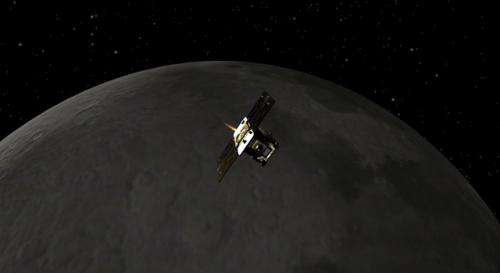First of NASA's GRAIL spacecraft enters Moon orbit

(PhysOrg.com) -- The first of two NASA spacecraft to study the moon in unprecedented detail has entered lunar orbit.
NASA's Gravity Recovery And Interior Laboratory (GRAIL)-A spacecraft successfully completed its planned main engine burn at 2 p.m. PST (5 p.m. EST) today. As of 3 p.m. PST (6 p.m. EST), GRAIL-A is in an orbit of 56 miles by 5,197 miles (90 kilometers by 8,363 kilometers) around the moon that takes approximately 11.5 hours to complete.
"My resolution for the new year is to unlock lunar mysteries and understand how the moon, Earth and other rocky planets evolved," said Maria Zuber, GRAIL principal investigator at the Massachusetts Institute of Technology in Cambridge. "Now, with GRAIL-A successfully placed in orbit around the moon, we are one step closer to achieving that goal."
The next mission milestone occurs tomorrow when GRAIL-A's mirror twin, GRAIL-B, performs its own main engine burn to place it in lunar orbit. At 3 p.m. PST (6 p.m. EST) today, GRAIL-B was 30,018 miles (48,309 kilometers) from the moon and closing at a rate of 896 mph (1,442 kilometers per hour). GRAIL-B's insertion burn is scheduled to begin tomorrow, Jan. 1, at 2:05 p.m. PST (5:05 p.m. EST) and will last about 39 minutes.
"With GRAIL-A in lunar orbit we are halfway home," said David Lehman, GRAIL project manager at NASA's Jet Propulsion Laboratory in Pasadena, Calif. "Tomorrow may be New Year's everywhere else, but it's another work day around the moon and here at JPL for the GRAIL team."
Once both spacecraft are confirmed in orbit and operating, science work will begin in March. The spacecraft will transmit radio signals precisely defining the distance between them as they orbit the moon in formation. As they fly over areas of greater and lesser gravity caused by both visible features, such as mountains and craters, and masses hidden beneath the lunar surface, the distance between the two spacecraft will change slightly.
Scientists will translate this information into a high-resolution map of the moon's gravitational field. The data will allow scientists to understand what goes on below the lunar surface. This information will increase knowledge of how Earth and its rocky neighbors in the inner solar system developed into the diverse worlds we see today.
Provided by JPL/NASA




















